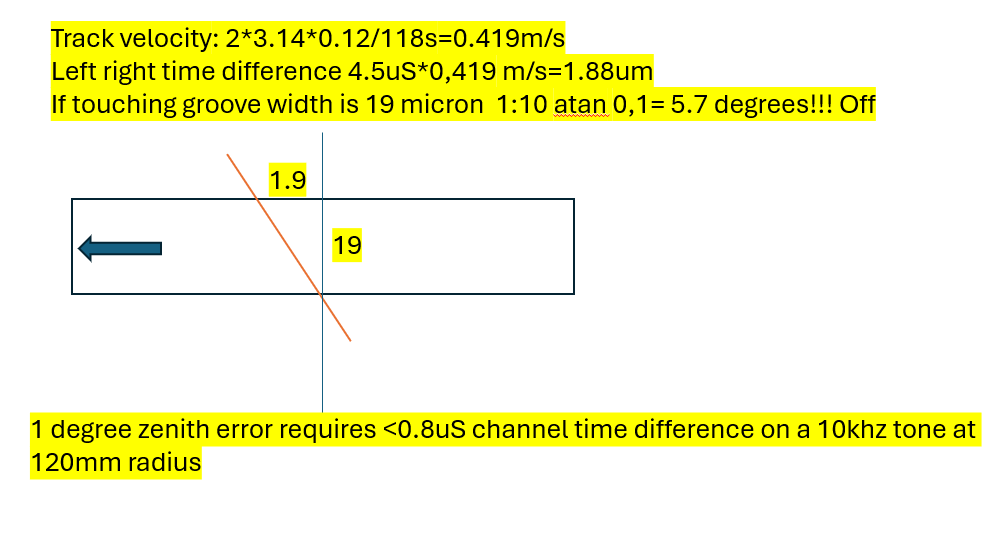https://www.hifisentralen.no/forumet/attachments/img_1860-jpeg.986321/
Last edited:
FYI; I tried this method with top Dinolite USB Digital Microscopes before I bought the Wally Scope.USB microscope , stylus resting on a CD..good lighting and trial and error .. Focus stacking if you want go get advanced.. The microscope came with an adjustable holder/foot , that is a must .
https://www.hifisentralen.no/forumet/attachments/img_1860-jpeg.986321/
Prevoius table was done with Ortofon as reference record, the tables below is Azimuth set with Toshiba test record, I may have used different cartridges.. the recent table below is with AT OC9MLii the previous could also be OC9 but I may have been AT 33PTGiiYes Crosstalk is depending on the record ,
You have to find one you believe in and that fits your average music record , easier said than done. Here I compared some of mine test records. Ortofon on considered to be good, even if I did not get the best values on that when I did the table below, since then I managed to get -32/-31 on the Ortofon and -35/-36 on some other records.
If you use RIAA or do not filter low end rubbish the values will be worse.

Wally has great stuff, I use Wally Fulcrum . My USB scope works quite well, the challenge is to get proper lighting,FYI; I tried this method with top Dinolite USB Digital Microscopes before I bought the Wally Scope.
After using the Wally Scope (with additional accessories for better and ease setting up & accuracy etc. as recommended by Wally Tools), I found I was miles out with using the Dinolite equipment.
And this was with setting up my cartridge with my Kuzma 4Point 11" arm and XL DC TT set-up (from my experiences of TTs over 40+ years one of the easiest TT set-ups to set up with good accuracy using the Wally Tools).
I will also add that you should seriously consider using all of the available Wally Tools available to set-up your TT.
What are the VTA values, and what kind of tracksignal is it ? Modulation? Stereo,lateral,vertical ?Further to Balle Clorin:
My Figures:
View attachment 138259
AM I and AM II software was tested against an oscilloscope and was shown to be accurate.....so the software is great..
Balle, what is the maker and model of this microscope? I like the stand better than the one I use with the Dinolite. I find the Dinolite too bulky and cumbersome to use safely near a delicate cartridge. And what capture software do you use, that allows for focus stacking?The microscope came with an adjustable holder/foot , that is a must
Thanks. I bought one of those years and years ago. It wasn’t provided with a stand, and at that time I don’t recall a focus stacking feature in the software. Maybe the newer ones are better.The brand is Andonstar @tony22. At least it was Andonstar when I bought it years ago. Looking at the previous pictures that shows the microscope I can say that it’s the same make and model.
It is or I should say it was Andonstar. I have one.Thanks. I bought one of those years and years ago. It wasn’t provided with a stand, and at that time I don’t recall a focus stacking feature in the software. Maybe the newer ones are better.
The stand doesn’t look like it has Andonstar printed on it.
No AM, it would be interesting to try but expensive. I do use CoolEditpro2( Adobe audition). I can do most of what AM can do by using CoolEdit and Parks Audio Puffin test function on some of my 30 test records, but I miss a good reliable Zenith track. I probably have spent more on records than AM cost.. but that is history..Dear @Balle Clorin do you have AM software or have you ever used it?
Do you have any tip on a good zenith track?I miss a good reliable Zenith track
Wrong zenith does not affect the modulated frequency (10kHz) and the peak levels are more reliable to study than the zero crossings. So you are doing it right in my opinion.But really the zenith test should be the zero crossings, not the peak? . Since the peak signal is where the stylus crosses the mid line of the modulation -highest velocity-, The zero crossing signal is where the stylus hits the peak modulation - zero velocity-. The derivative of a sinus = cosines …
But if distortion and low frequency movements are not perfectly equal in both channels the zero crossings and peak in the volt signal are not consistent, they are biased and moving. This puts the whole test method in question.. I would like to find a second method to confirm the results.. that could be lateral modulation IMD test, similar to vertical IMD for VTA..but which track could be trusted for that..
Not sure how AM does it..
Not sure I have the right contact point distance for L and R stylus in groove width, but even 1us channel time difference is then about 1 degree off zenith. I have adjusted my cartridge for other reasons and get this today, hard to believe I am 6 degrees off, but that is whet I getWrong zenith does not affect the modulated frequency (10kHz) and the peak levels are more reliable to study than the zero crossings. So you are doing it right in my opinion.
What affects the frequency is w&f, and we are looking at an instantaneous frequency here, but for phase difference it will be a very small error if any.
The best way I find is to increase the gain for the silent channel some 20dB, i.e. a if you can use a two channel gain stage to feed the OS. This will improve the waveform on the OS.


| Steve Williams Site Founder | Site Owner | Administrator | Ron Resnick Site Owner | Administrator | Julian (The Fixer) Website Build | Marketing Managersing |






